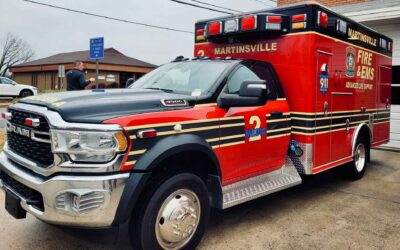
Horton Emergency Vehicles built this Type 1 ambulance on a Ford F-550 4×4 chassis and two person cab for Hopedale (MA) Fire Department. (Photos courtesy of Hopedale Fire Department.)
By Alan M. Petrillo
Hopedale (MA) Fire Department is a bedroom community of 6,000-plus residents located about 30 miles west of Boston that covers its district with a paid chief and deputy chief, eight paid full-time firefighter/paramedics, and 22 paid on-call firefighter/paramedics and emergency medical technicians (EMTs) from a single station that houses two ambulances, three pumpers, one tender (tanker), one aerial, an off-road brush truck and one special hazards vehicle.
Thomas Daige, Hopedale’s chief, says the department was seeking to replace an older Type 3 Wheeled Coach ambulance. “The fire department started doing ambulance services in 1999, and we’ve been running all Type 3 ambulances until this new purchase,” Daige says. “We decided to go with a Horton Type 1 ambulance for several reasons. They had the quickest turnaround build time, we talked with a lot of agencies that use Hortons around us and they were very happy with Horton, and our E-series cabs were a little too tight.”

The Horton Type 1 has a Cool Tech 100,000-BTU condenser with four-smart fan technology and a solar panel.
Dave Marshall, director of sales for Horton Emergency Vehicles, says the new Hopedale Type 1 rig is built on a 2023 Ford F-550 4×4 chassis with a wheelbase of 193-inches, a two-person cab, and a Horton 623 aluminum body that’s 173-inches long with 74-inches of headroom. Marshall notes the Hopedale ambulance has a Liquid Spring rear suspension, a Cool Tech II 100,000-British thermal unit (BTU) condenser for the air conditioning system with four-smart fan technology that includes a roof solar panel, a Vanner inverter with a status panel on the exterior of the rig, a Kussmaul 20-amp Super Eject charging port, and electronic privacy windows on the patient module.
Brian Zarlenga, salesperson for Greenwood Emergency Vehicles, who sold the rig to Hopedale, says another reason the department changed to a Type 1 4×4 from a Type 3 chassis was to avoid having to use tire chains in the winter months. “Also, there are a lot of good features for medics to be able to reach supplies while staying belted in, instead of getting up,” he notes. Zarlenga says the Hopedale Type 1 has the Horton Occupant Protection System (HOPS) which includes four-point detachable Per4Max seat belts that allow for shoulder and lap belt application, progressive resistant cushions similar to a motorcycle helmet that allow the head not to bottom out on the cushion, and three roll protection air bags, two tube style to prevent the upper body and head from moving under the cabinets, and an air curtain in the action area.

Hopedale’s new ambulance has Horton’s chevron lighting at the rear of the rig.
The interior of the rig Marshall points out, has Horton’s I4G Plus multiplex electrical system, a GC Tech interior, three control switch stations in the patient box, and two different infectious control systems consisting of a HEPA filter for the HVAC system on the return vents, and also an ActiveTek In Duct 500 air purification system. He notes the ambulance has three-drawer cabinet beneath the pass-through, a Robinson rollup door on the advanced life support (ALS) cabinet, an intercom system, a backup camera, and an observation camera above the rear doors in the interior of the patient module.
Lighting on Hopedale’s Horton Type 1 ambulance includes a Whelen LED emergency lighting package, Whelen LED scene lighting, a GoLight on the cab roof, and Horton chevron lighting at the rear of the rig.
ALAN M. PETRILLO is a Tucson, Arizona-based journalist, the author of three novels and five nonfiction books, and a member of the Fire Apparatus & Emergency Equipment Editorial Advisory Board. He served 22 years with the Verdoy (NY) Fire Department, including in the position of chief.




